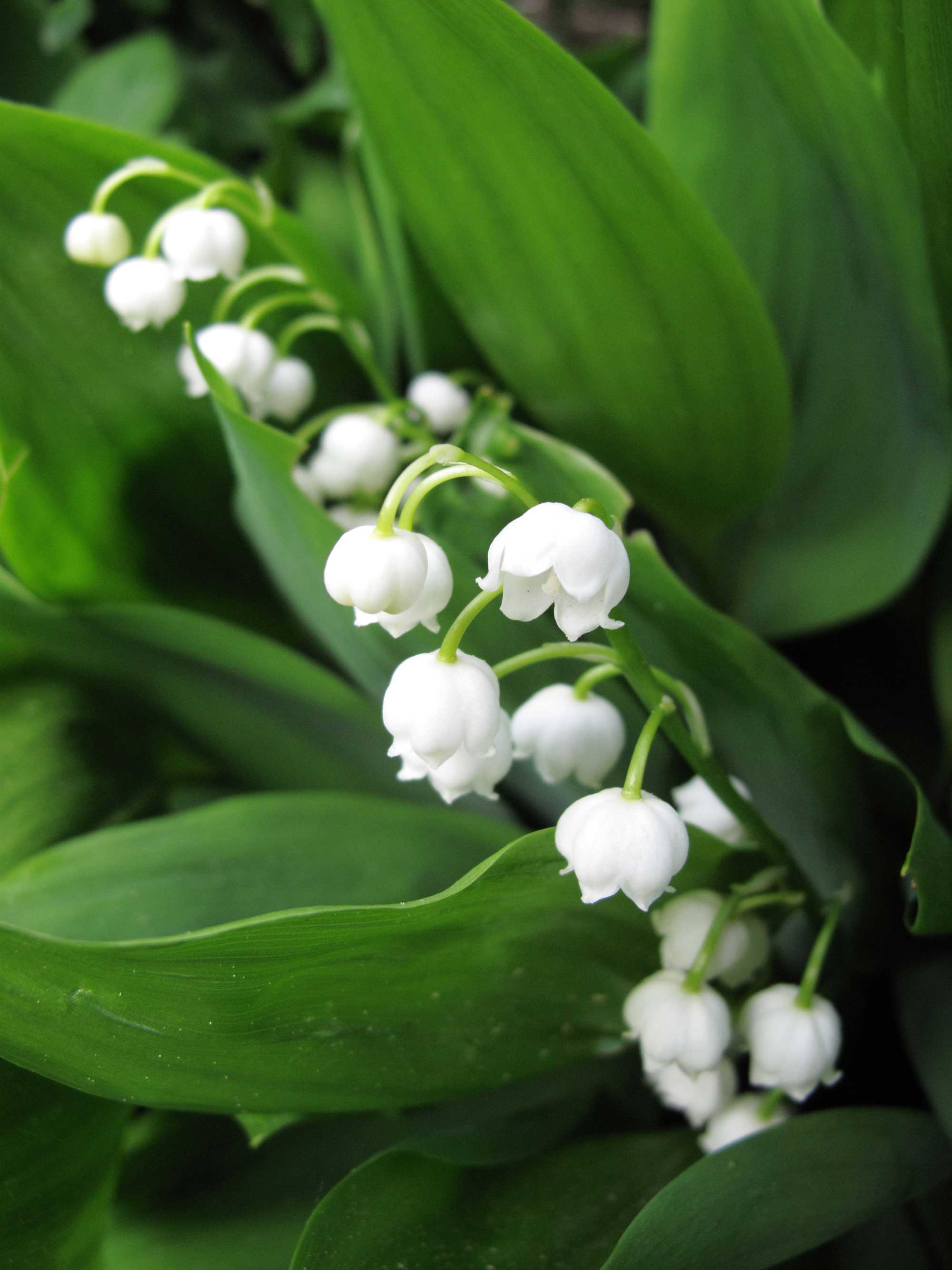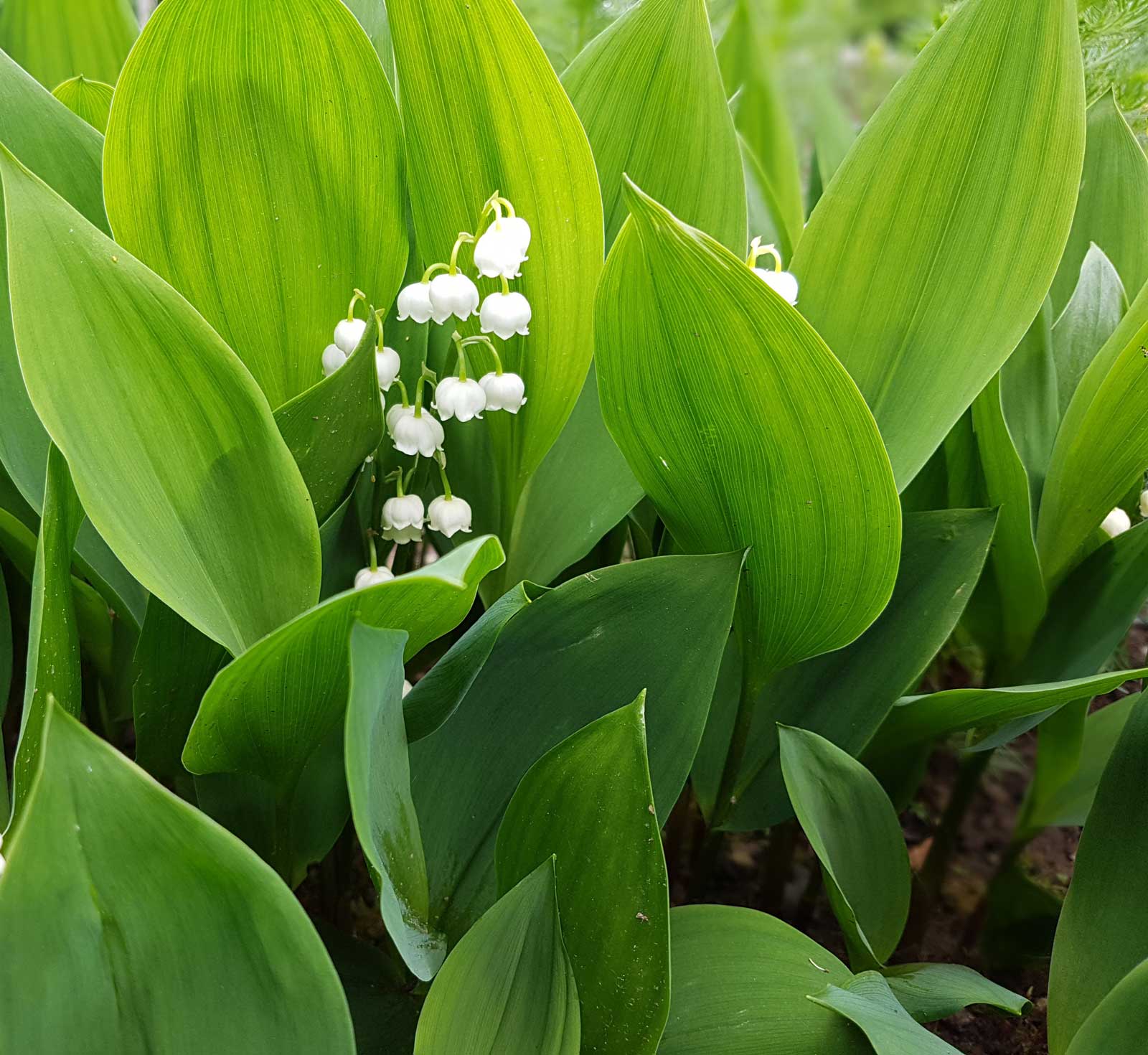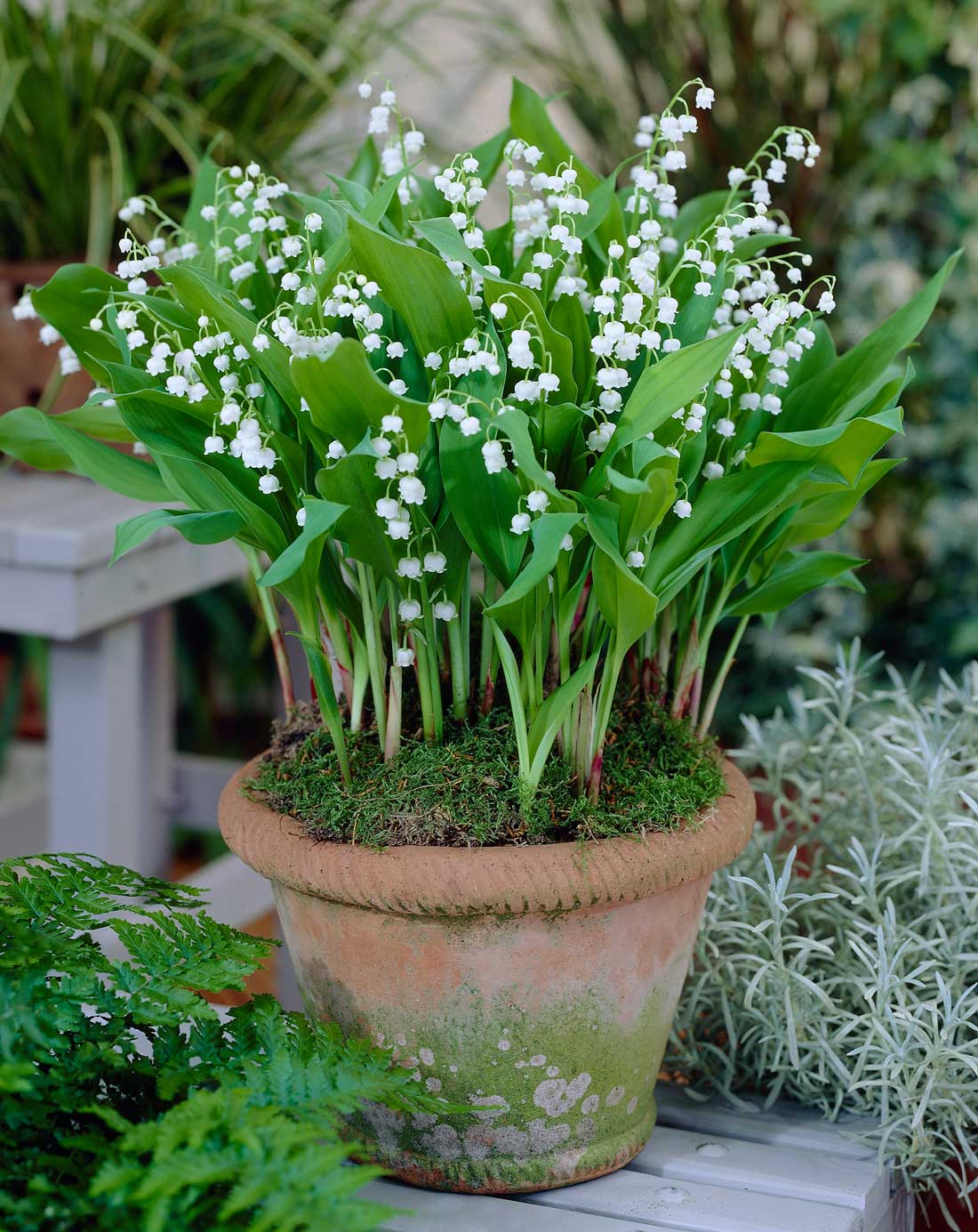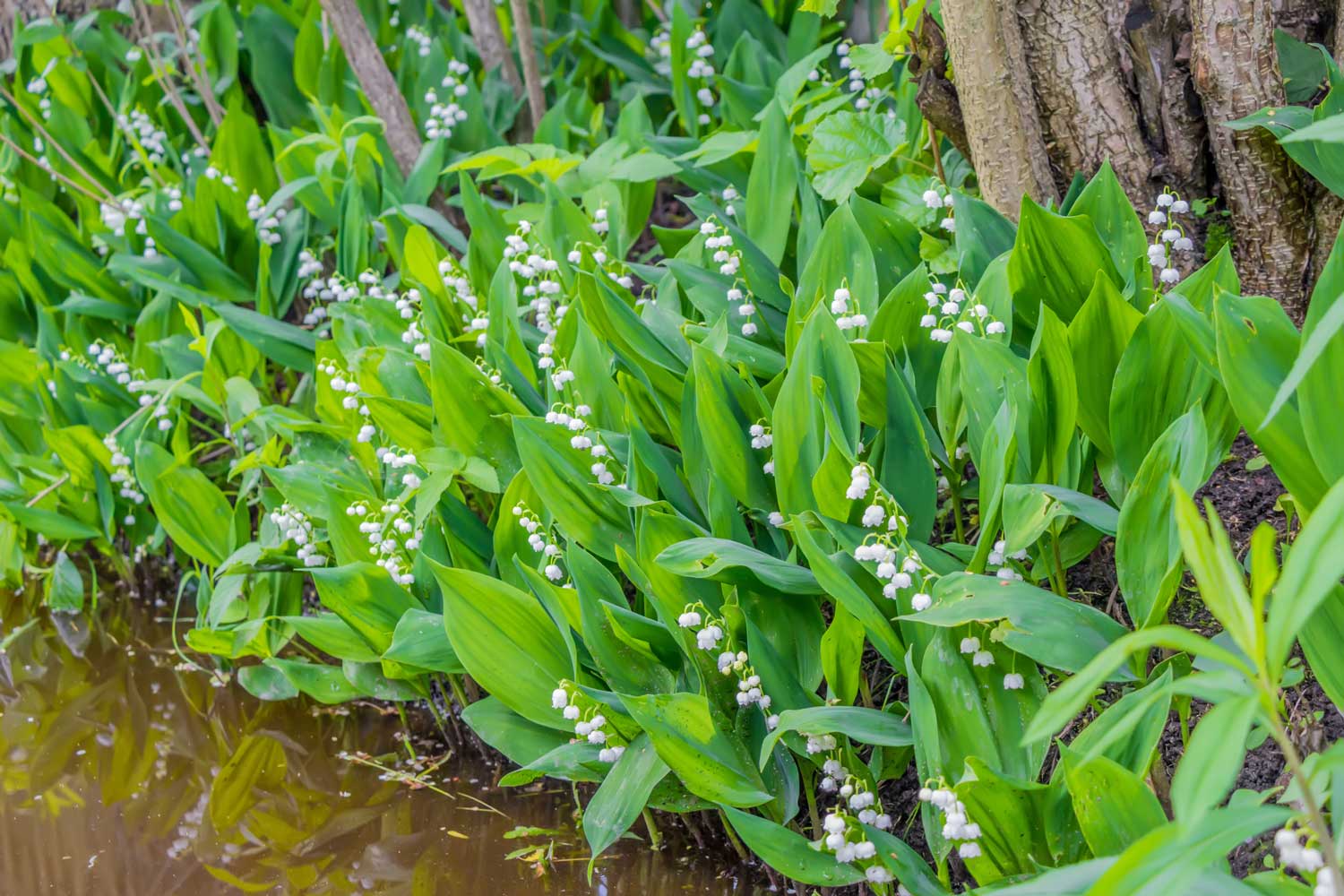Growing Lily of the Valley: Tips and Tales

Lily of the valley has a long and fascinating history. Over the centuries, these fragrant little blossoms have inspired stories, songs, poetry, festivals and folk traditions. When I was a child, singing rounds was a big thing and my favorite was always:
White coral bells upon a slender stalk
Lilies of the valley line my garden walk.
Oh, don’t you wish that you could hear them ring?
That will happen only when the fairies sing.
Another tradition from my childhood was “May Day.” On the first day of May, we would make nosegays with little flowers like violets and lily of the valley. We put these miniature bouquets into baskets made from construction paper or milk cartons, and would run through the neighborhood, secretly hanging the baskets on front doors so our gifts would be a surprise.
Where to Plant Lily of the Valley
Lily of the valley is treasured for its waxy, pure white flowers and unforgettable perfume. In the garden, it’s a shade-loving ground cover with thick, fleshy roots that crowd out weeds and other plants. The shiny, bright green leaves becomes a lush carpet of foliage that keeps landscaped areas looking neatly maintained with little or no attention.
The plants are extremely tough and will grow in almost any type of soil. They also tolerate both cold (zone 3) and heat (zone 9). The roots love moisture, but once established, they are quite drought tolerant. In warmer zones the foliage may stay green throughout the winter.
Consider planting lily of the valley beneath shade trees or shrubs, against the foundation of a building or around a water feature. It’s also a good solution for steep banks and uneven terrain where it’s difficult to maneuver a lawn mower.
Lily of the valley prefers growing in dappled light, but it’s one of the few plants that can take full shade. If your yard has a dark, forlorn area near an outbuilding or under a fence, it may be just the thing. You’ll get a weed-proof ground cover with the bonus of pretty spring flowers.

Right Plant, Right Place
Lily of the valley is a ground cover, and if you use it that way, you will love it. If you treat it like a regular perennial and add it to your flower garden, you may be sorry.
I wish I had known this when I started planting my shade garden. With all those wonderful childhood memories, lily of the valley was one of the first plants that I put in. For the first few years, it grew slowly and gradually filled a 2’ x 2’ area. Then one year it began to spread. Before long, it choked out all my primroses and had gone on to invade the epimediums, heucherellas, pulmonarias and other treasures. I tried to keep it in check by digging out the runners, but didn’t succeed.
Eventually, I hired a neighbor’s son to dig out almost my entire shade garden. Then I combed through both soil and plants to remove any sign of the lily of the valley. I put the roots, shoots and stems into a plastic trash bag and the rest of the plants went back into the garden. Random leaves popped up here and there, but I diligently dug them out and now they’re completely gone.
The good news, is that I had also planted it in a damp area next to our woodshed — the right place for a ground cover! It keeps the area looking neat and gives me all the flowers I need.

A Coveted Cut Flower
Of course, one of the best reasons for planting lily of the valley is to have your own supply of flowers, free for the picking. To my eye, spring’s sweetest flower arrangement is a combination of muscari, violets, primroses and lily of the valley.
Generations of brides have carried bouquets of lily of the valley (including Kate, the Duchess of Cambridge). Fragrances are powerfully linked to memories, and what better way to remember a special day than with this distinctive perfume.
The roots can also be dug up in the fall or in early spring, and forced in pots — as you would do with tulips or hyacinths. I have never tried it myself, but what a gift that would make!
When you have your own patch of lily of the valley, you can celebrate the holiday La Fête du Muguet. On this day – May 1st – people throughout France give little bunches of lily of the valley as tokens of affection to family and friends. To make your own French-style bunches, cut a fistful of flowers and leaves, and tie them together with raffia. Happy Spring!
To learn more, read All About Lily of the Valley. To shop for plants, click HERE.



Love to have your beautiful Lillies of the velley, but too hot in Corpus Christi, Texas!
Hi Stella — That is true. Of course us northerners pine for your plumbago and oleander!
I’m in Galveston County Stella and so far so good growing this. Just have a small area and it’s well shaded. Reminds me of growing up in northern Illinois.
Hi Debby — There’s something about lily of the valley and memories. Maybe it’s that heavenly fragrance that transports us through time.
they are so pretty, the white against the emerald green. I hope to try to plant them in our garden
Hi Jennifer — Nothing else like them! And such a fabulous fragrance.
I love these. My grandmother had them in her yard so many memories. Question please. I read you can sink a pot in the ground and plant your lilies of the valley in that to avoid the issue you had. Is that true?
Hi Janet,
I haven’t tried that myself, but I see no reason it wouldn’t work. I grow mint in an 18×18″ diameter plastic nursery pot. Dig a big hole, cut out the bottom of the pot, put it in the hole and fill with soil and the plants. Make sure the lip of the pot sticks out of the ground by about 2″ so the plants can’t sneak over the edge. Works great!
I love Lily of the Valley. They were my father’s favorite. I now live in Georgia and have not had success growing them. Also, the deer that roam our property, love them! Any tips out there to grow them successfully? Thank you!
Hi Karena, Lily of the valley are not fans of hot weather. If you want to give it another try, choose a shady planting area where the soil stays relatively cool. Start by amending the soil with compost and whatever other soil conditioners you use in your area. This will improve drainage as well as the soil’s ability to retain moisture. Plant the pips and water them weekly for the first growing season — until the roots get well established. Mulching the soil will help keep it cool and hold moisture. Good luck!
Why don’t my lily of the valley flower?
Hi Pat – There are two common reasons for plants to stop flowering. The first is not enough light. Lily of the valley actually prefer growing in partial shade, but if they are in deep shade, like against the north wall of a house or under evergreens, they may need more light. The other reason is overcrowding. If your plants have been in the same place for a long time, they may have become a mass of roots and stems with not enough space to thrive. A relatively easy way to give them more room is to remove about 1/3 of the plants and let the others expand. Just use a shovel to dig out sections of plants and then go back and fill the empty spaces with soil. Hope this helps!
I live in Conn. and have tried twice to grow these lovely flowers with NO luck,help I love these
Hi Jo-Ann — Lily of the Valley needs consistent moisture until the plants get well established. After that they can tolerate relatively dry soil. They also prefer at least a half day of shade. Start by planting a group of the pips relatively close together so you can keep an eye on them and they can establish strong roots. A year or two later you can transplant them into different areas (so this in early spring before the foliage unfurls). Hope this helps!
Is it wise to not pick every flower so as to let some develop seeds to drop and keep the patch thick? Mine used to have way more flowers than last years and this years batch. I’m wondering if I over picked in 2018 and did not leave any to form seeds to drop. I look forward to your thoughts about this. Thank you.
Hi Carolyn – Lily of the valley spreads by underground runners. Picking the flowers will not affect growth. If the number of flowers has decreased, the plants may not be getting enough light or if it’s an old planting, they may have become too crowded and need division.